S.A. Cert.Licence AB18834
Cathys mobile: 07515637562

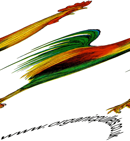
Ben and Cathy Wetherden
Organic Pullets
Bens mobile: 07812048323
Range reared & certified organic pullets from day old up to point of lay
Email: info[at]organicpullets.co.uk
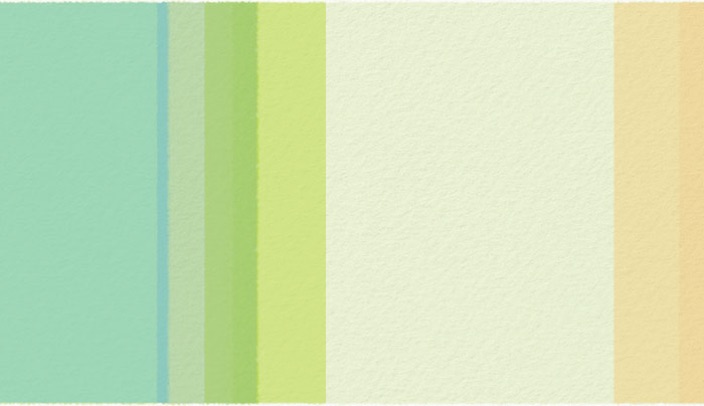
We sell pullets at any age from day old ( Mareks, I.B, & Coccidiossis vaccinated) up to 18 weeks, in any quantity.
Caring for younger hens:
The younger the pullets are, the more complex care they will require, for example they will need heat throughout the day if kept in their own house. This is made easier if you have a broody hen, as she will take care of keeping them warm.
Once they are over 5 weeks old, they are generally off heat. At 6 weeks, they will go from chick crumb to grower pellets. We recommend letting the hens roam outside daily from 8 - 9 weeks, however this can be later if you have issues with crows, birds of prey who will take smaller hens.
Caring for hens from point-of-lay:
By the time they are 18 wks they should have built up a good immunity, (we use homeopathic treatments to help with this), and will be perching, and ranging further from the house.
Point of lay is a pullet at 16-18 weeks, although depending on the time of year, day length, weather, change of feed, breed and also the stress involved in the move it could be another 4 to 10 weeks before they start to lay.
The longer the day the quicker they come into lay, although the longer they take to come in to lay the quicker the egg size increases.
All of our pullets have a natural day length, so will not be affected by a non-lit house. If possible it is a good idea to close off the nest boxes for new arrivals,(this can be done with thick paper or cardboard)for a day or two, so that the pullets don't start to sleep in them. You can then open them up again when they are all perching at night.
Feeding:
It is important to feed pullets on a good layer mash (fed dry) or pellet feed with a protein level of 18%, they are best fed ad-lib so that they all get a good chance to eat; they will need approximately 140g of feed each per day.
Mash is better for preventing boredom vices that start if they are in a confined space. All our pullets are fed pellets as it stops selective feeding, theres less spillage and they can eat quickly before they go outside.
It is a good idea not to feed too much corn until they are fully in lay and no more than 25g a day per hen and only in the late afternoon or evening as a scratch feed. It takes a while for the hens to digest corn and it is only usually around 10% protein.
An egg is approximately 13% protein so if corn is fed in large quantities egg production is usually low or can stop altogether depending on natural protein sources. Hens usually prefer to eat corn than a meal or pellets.
Hens also require grit to be fed separately, this acts like teeth and helps to grind down their food in the gizzard.
Giving birds access to oyster shell, or a mixed grit that contains oyster shell, separate to their feed can be beneficial for strong egg shells due to the digestible calcium content.
However, be wary, giving calcium in their water especially to young pullets, as too much calcium can cause their bodies to stop absorbing it altogether.
It is a good idea to keep the feed in the house where it will stay dry and away from wild birds and vermin.
Moulting:
Once hens are over a year old they are likely to go through a moult, where they will change some or all of their feathers.
This happens in the autumn and can take 8 weeks, egg production at this time is usually very low or non existent. It is a good idea to worm all poultry at this time of year, as a minimum.
Moulting can happen at other times of the year if a short day is simulated.
Housing and space:
Soil Association organic standards for laying hens require 18cm of perch space per bird, 1 nest box per 6 hens, 6 hens per m2 of house space and 10 m2 of range per bird. Maximum flock size of 500 hens (2000 with a derogation).
Hen houses should have water tight roofs that do not leak, plenty of straw bedding for warmth and access to fresh clean water at all times. Houses should also have sufficient ventilation to allow fresh air into the space.
Hens tend to eat during the daylight hours so ensure that their food supplies are topped up and that they are not out of food during the day.
If the hens are not provided enough space it can cause them great stress, leading to possible feather pecking amongst the flock and sometimes death.
Our hens are reared to the highest standards, and we hope that you will continue this welfare.

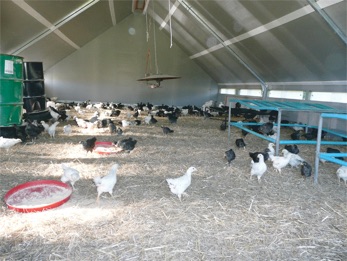
A mix of 3 wk old pullets in one of our houses
At only a few days old chicks enjoy burying themselves, this is called dust bathing. Once outside they will enjoy doing this in dried dusty areas to help protect themselves from mites and other small insects.
Caring for Your Hens
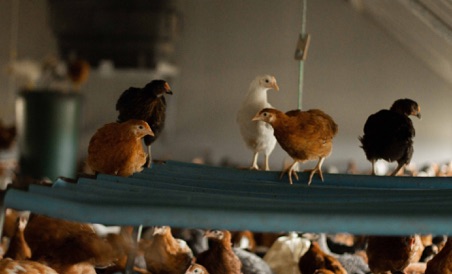
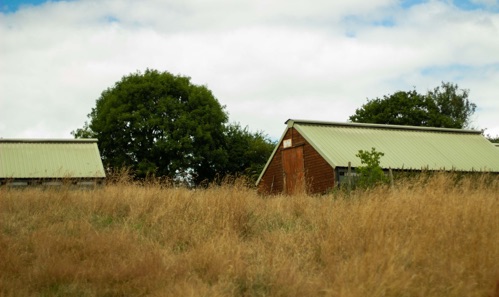
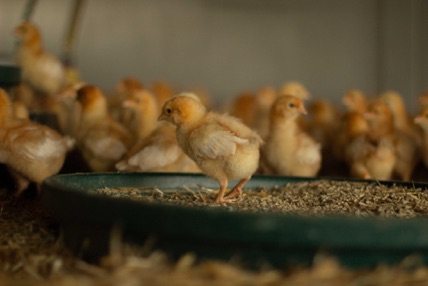

© 2023 Cathy Wetherden all rights reserved